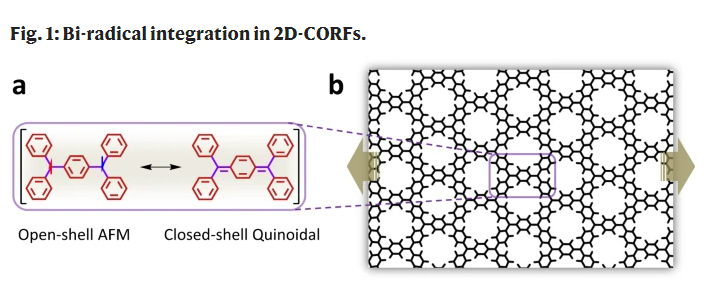Controlling the pairing of π-conjugated electrons in 2D covalent organic radical frameworks
Strain brings electrons together
Published in NATURE COMMUNICATIONS, a collaborative theoretical study involving three groups from the IQTC shows how to reversibly switch between closed-shell and open-shell states in radical-based 2D organic materials. The work was also featured as an Editor’s Highlight (www.nature.com/collections/eecgdgijhh).
Controlling the pairing of π-conjugated electrons in 2D covalent organic radical frameworks Isaac Alcón, Raúl Santiago, Jordi Ribas-Arino, Mercè Deumal, Ibério de P. R. Moreira & Stefan T. Bromley, Nat. Commun., 12, 1705 (2021)
Since the discovery of graphene, an increasing number of inorganic 2D materials with a range of physical and chemical properties have been synthesized by top-down approaches. However, in practice, 2D inorganic materials possess very high in-plane tensile strengths, which only allow for moderate strains generating modest electronic changes.
In parallel, chemists have developed alternative bottom-up synthesis approaches based on linking arrays of molecular building blocks, to produce 2D covalent organic frameworks (2D-COFs).
Building on previous proposals the authors show that a particular family of 2D-COFs may provide an ideal basis for highly sensitive strain-control of electronic properties. Using persistent radicals as building blocks for new two-dimensional covalent organic radical frameworks (2D-CORFs) promises to provide a platform for new flexible materials in which optical, magnetic and electrical properties can be reversibly controlled by modest structural strain.

In this work, they study the effect of uniaxial in-plane strain on a series of 2D covalent organic radical frameworks (2D-CORFs), by means of density functional theory (DFT) based calculations. Their results demonstrate that uniaxial in-plane tensile strains may be used to efficiently switch between the AFM multi-radical (i.e. spin polarised or open-shell) and diamagnetic quinoidal (i.e. closed-shell) states in a reversible manner. In addition, they demonstrate that the strain-induced electronic switching is robust at finite temperatures, which is a prerequisite for its experimental viability, and thus technological applicability. Overall, their work shows that integrating bi-radical moieties into covalent 2D materials is a promising route to achieve macroscopic control over molecular-scale electronic states.
Would you like to know more?
Check out the original article in Nature Communication: Controlling pairing of π-conjugated electrons in 2D covalent organic radical frameworks via in-plane strain
Check out a “Behind the paper” post by Stefan Bromley at the Nature Portfolio Chemistry Community: Strain-induced radical change: a 2D perspective
